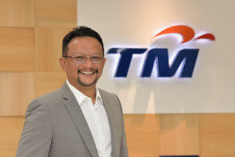

To successfully achieve a productive balance in today’s new, AI-powered highly challenging era, human-centred technology needs to be at the top of the planetary agenda. This was the consensus of top industry experts at the recently held LEAP 2021 summit in Malaysia, organised by TM One, the business technology solutions arm of Telekom Malaysia.
Indeed, adopting a human approach is rapidly becoming a core driver behind numerous digitally powered growth and recovery strategies across many forward-thinking countries amid today's rapidly shifting Covid-19 scenario together with other dynamics.
Malaysia's own digital economy, boosted somewhat by a lockdown-related 68% surge in eCommerce, will grow to RM80 billion in gross merchandise value (GMV) by 2025, according to the 'e-Conomy SEA 2021: Roaring 20s — The SEA Digital Decade' report by Google Inc, Temasek Holdings and Bain & Co. This report also notes growth other sectors — such as food and transport increasing by 35%, and online media by 14%. The e-Conomy study also highlights the dramatic growth of digital consumers, currently 94% prefer digital transactions — on average 4.2 times more than in the pre-Covid era.
In his welcome keynote to industry leaders at the 4th edition of TM One’s annual flagship event for public and private sector leaders, themed Human-Centred Technology: Taking Transformation Forward, Imri Mokhtar, group chief executive of Telekom Malaysia (TM) said industry studies clearly signal a sea change in human behaviours.
In his welcome keynote to industry leaders at the 4th edition of TM One’s annual flagship event for public and private sector leaders, themed Human-Centred Technology: Taking Transformation Forward, Imri Mokhtar, group chief executive of Telekom Malaysia (TM) said industry studies clearly signal a sea change in human behaviours.

The Power of Knowing
“The accelerated adoption of technology in the post pandemic era shows the world is ready for this change in the norm of how we work and live. Customer expectations have evolved to the point where the ultimate experience is typified by a seamless digital journey,” commented Imri.
“To drive this forward, requires the right organisational DNA including agility and a collaborative, human-centred approach,” he said, when outlining some of the milestones for the TM Group. “As a national institution, TM has evolved into a human-centred technology company, inspired by this dynamic evolution of customer needs and desires. Our capabilities to address human needs and easing processes is demonstrated in multiple areas.”
Examples included making unmanned platforms a reality in the O&G (oil & gas) sector, which reduced exposure to risk while maintaining productivity, while in manufacturing, the use of advanced automation is making light work of formerly resource heavy processes. In TM itself, the use of AI to enhance operations has already automated 230,000 work hours, which can be pivoted to empower employees with higher quality work and help them take control of their time.
However, the key to achieving such milestones lies in the power of knowing, and to recognising opportunities in the face of adversity, he explained. “The power of knowing requires balance between human and technological intelligence in order to delight the customer. The next wave of innovation, arising from digital technology and human skills, requires collaboration, innovation and an open coalition to benefit all Malaysians."
Human-Centred Transformation
Following TM One Leap’s tradition of drawing global thinkers, the next keynote speaker, an advocate for human led innovation, Shivvy Jervis, Founder of FutureScape248, and award-winning futurist, echoed Imri’s thoughts, commenting that the current challenges faced by leaders in Malaysia have much in common with the rest of the world.

“Malaysia's experience is common, and I welcome the country's proactive approach in finding fresh ways to build a hybrid scenario and to see digitalisation's role grow as a lifeline for citizens through public services.”
Commending the country’s digital prioritisation and TM’s leadership as a change driver, she added that delegates at the event constituted a “collective of the brightest minds in the country’s industries and government, and are the change drivers for Malaysia in these times, when we must become future ready by creating meaningful changes, and to making digital transformation truly human.”
“The future is far more hopeful than you and I think,” she said, when explaining her interest in areas including scientific advancements, brain chemistry and digital breakthroughs.
Shivvy cautioned that the failure rate for transformation projects was high. “Firstly, we need to break down the idea that digital transformation is just a technological challenge to be addressed by the digital people; 60 to 70% of organisations treat transformation exercises solely as technological.”
“Human-centred technology can revolutionise services, but only if the people rolling out these initiatives understand human expectations and balance this with technological advances,” Shivvy continued. “You need to build fluidity into the digital value chain, rather than just a linear project planning approach. You should also ensure you have the right skills and talent into place, decision-making requires a more holistic approach, balancing board level expectations with the IT leaders; everyone needs to be at the table and move forward with clarity and a moral code.”
Humanity 5.0
A moral code is more than just a philosophical concept, it is a set of ethical values, she explained when giving examples from her client roster. “Our Humanity 5.0 Guide suggests that organisations have a responsibility to their workforce and to their communities. This approach ensures a stronger path to successful transformation; such organisations can attract three times more talent than their peers.”
Turning to some innovations and concepts that would build ‘future readiness’, she said the world will be largely influenced by adaptive artificial intelligence (AI).
*Adaptive AI *is a term coined by her lab, which had for five years been tracking the ways to bridge the gap through design between man and software. “This was to understand the human way of thinking, and these tools essentially give social intelligence to coding, and has resulted in up to 30% cost savings.“
Considering Malaysia’s 5G plan from the end of this year, Shivvy said. “Low latency and higher firepower will strengthen many tools such — as AR, robotics, and advanced data science — and open up new abilities and uses - especially towards an ‘internet of senses’ — connecting us to bodies, skills, people, and things: the internet of things is evolving in to the internet of senses.”
“Other examples include e-learning platforms that will better adapt to individual needs, and many tedious processes will be removed from our plate, although there is a caveat: we have to be mindful of ethical oversight. Mindfulness of data privacy. The evolving technology is reading us better and decoding our moods better.”
The broad benefits include the building of everyday ecosystems - cities - “where we are developing the ability to prevent issues that could become serious problems, including pollution”, she said, adding that another emerging innovation lies in digital twin models. “An exact digital replica of our body can help with virtually test experiences of the impact from citizen services, traffic, and so on.”
This is an example of what Shivvy calls the ’tactile internet’ and which has opened up uses such as a remote arm for surgeons to enact some procedures. "Another near future example is the use of digital pills containing tiny sensors, which can be injected into the body and then transmit key data to our phones, could help warn us hours in advance of serious episodes,” she said. “We could track trends in the population — with user permission, of course — such as disease waves, and mitigate these before they escalate into pandemics."
"Let me end with a shout-out to TM One; they are at the vanguard of taking transformation forward. Empowering the digital journey and humanising transformation. Hidden opportunities."
"The future is now - and it is human-led," she concluded. "Keep the human spirit at the front. Market dynamics are changing across the world. Review and refresh and how we will adapt to change. Collaboration with the right partner is possibly one of the key factors to be future ready."
Panel: 'Design is how it works'
‘Design is not just what it looks like and feels like. Design is how it works,’ so said Tim Kobe, founder & chief executive officer of Eight Inc, quoting Steve Jobs of Apple.
Renowned as the mind behind the design of Apple Store, Tim Kobe, was participating in a panel session - themed critical design aspects of everyday things - with other experts Shamsul Majid, chief technology & innovation officer from national regulator MCMC (Malaysian Communications and Multimedia Commission), Sudev Bangah, managing director of IDC ASEAN, and with Manoj Menon founder & manager director, Twimbit, acting as moderator.

Sharing from his 12 years’ experience working with Steve Jobs, Tim revealed that one of the strongest learnings is to think with both the left and right sides of the brain, “with both an analytical and intuitive perspective. Nine times of 10 though, Steve will trust his intuition. The Apple culture was borne from defining the culture you want to be known for, setting up a system to support this, and the team of teams that can help you deliver that.”
Talking to the concept of human centric technology, he elaborated that this was “a return on experience. Many people look at it from a business perspective. But the return on experience is the fundamental factor of the success behind Apple or Virgin. It is the design defines human progress In terms of the way we think and do things.”
“Steve taught that design is not just what something looks like, design is what it does for people: design is how it works,” he said. “When designing for people, you have to understand the types of things that influences behaviour, and this includes looking at the more primitive aspects of the brain {the non-verbal aspect}. Experience is a powerful aspect which influences behaviour. Experience is holistic — an expression of a core set of values that people feel. For example, communicating the values of what Apple stands for.”
Analyst findings that Tim cited include:
Tim said the key is to move beyond thinking about transactions, and look at relationships with a product or service. “Ultimately, great human outcomes lead to great business outcomes. A value creation engine is about human outcomes, which leads to the strategy and the tactics. The secret to value creation is human experience creation. In a meeting, Steve would ask what would competitors do; and then say, let us not do what they would do; let’s go in a different direction: this was a strategic decision.”
Companies that have taken that risk include Apple Global Retail, which grew from USD2 billion to 2 trillion in USD market value. Meanwhile, Virgin Atlantic Airways, is consistently in the world’s top 5 listing for over 10 years, despite not having the same capital or lucrative routes of the bigger companies. Globe Telecom grew from 23% to 56% market share by shifting from ‘selling pipes to delivering emotion’.
Asean perspectives
“Emulating this approach in ASEAN may be more difficult because you don’t have the same competitive pressures in the public sector; though I understand some cities in Australia see themselves in competition with other cities in the country,” opined Tim.
Sharing his thoughts on the Asean perspective of human-centred experience, IDC’s Sudev said that the Southeast Asia region had shown considerable interest with 60% of organisations reporting that they are increasing investment in technologies to enable CX and UX to drive better customer engagement and loyalty, which they felt they had lost since the start of Covid-19.
“However, my concern is that much of these investments still seem to be around technology rather than on forwarding human/emotional related discussions is relatively low,” he continued. “For example, Malaysia is one of the countries where the ownership of UX, and its expectations, are by technology teams.”
There is more positive UX development in Indonesia, for example, especially among insurance companies, he revealed. “Design thinking is increasing in that country and with putting people at the centre of things. Non-MNCs are still too focused on technological aspects, even though 73% of consumers want a differentiated product/experience. We see much imitation and not much of human-centred initiatives. On a positive note, TM One is one of the organisations out in front.”
In the discussion about how super apps could transform the citizen journey, MCMC’s Shamsul pointed to MySejahtra, which connects users with Covid-19 information, data, health, vaccination, and mitigation management.
“All Malaysians were scrambling for a single trusted point of information and help, and MySejahtra has filled that role. Looking to the future, we held a national super app survey, as part of understanding citizen needs. 84,000 respondents favour a national super app, provided data privacy concerns have been addressed. In 2022, MCMC will reveal more about our increased focus on a human-centred approach.”
Shamsul, together with Sudev, Manoj and Tim, urged thinking ‘outside the box’ by “looking outside your industry into any other industry. Moreover, break down silos within the organisation. Try different things, and be open-minded.”
Tim’s concluding remark summarises many of the panel’s key rejoinders: “If you are not focusing on the outcomes you are creating, you are probably leaving money on the table. Look at focusing on outcomes at the primary level.”
“If you look at history, tech tends to improve things and delivers on value to people, whether they knew they required it or not. Look for the gaps: for example, passports, which is definitely outdated technology, is screaming for a solution!”
Demystifying digital services
Eyeing the coming new year in her closing keynote, Shazurawati Abd Karim, executive vice president of TM One, reiterated today’s themes of the power of knowing, a human-centred approach to transformation, and powerful design thinking.
“To stay ahead of the game, we have to continue to transform and embrace new frontiers. Bringing about the quantum leap for our digital services rests firstly on AI, which is definitely our BFF! AI is a competitive necessity for all businesses, driving new levels of efficiency for businesses of all sizes. According to IDC, 40% of SEA firms have adopted AI to some extent, with another 37% planning to in the next five years.” - Shazurawati Abd Karim

Furthermore, she said the adoption of AI, if properly implemented, could add US$1 trillion by 2030 to Southeast Asia’s GDP, according to a Kearney study.
“Already AI is part of our everyday daily life,” said Shazurawati, citing examples including navigation apps such as Waze, Google Maps, Food Panda, and pandemic related apps. AI is also key in detecting malicious cybersecurity threats.
She also expects that the coming of 5G will engender a further boost to machine learning and AI capabilities, enabling faster predictive analysis and decision-making. “IDC research suggests that with investments in IoT, enterprises can yield improvements in business operations by at least of 30%, and the enhancement of employee safety and security with better monitoring of health and safety targets.”
Many of the benefits are applicable across multiple sectors. In Smart agriculture, the use of sensors on farms to monitor growth metrics such as temperature and moisture levels are driving significant improvements in yield.
Another key for enterprise is the use of mobile apps, which have achieved ‘fashion necessity’ status, Shazurawati said. “Mobile applications now every aspect of daily life. According to Statista, worldwide mobile app downloads are increasing to 161 billion by 2023. Mobile phones currently account for 70% of all user traffic.”
“Today, 42% of adult population have used at least one on-demand service — for food, groceries, medicine & parcel deliveries, and on-demand B2B services. In 2022, we will embrace more on-demand services — and businesses must adapt to this dynamic demand in digital services.”
Moving forward, Shazurawati urged enterprises to fundamentally manage change in digital services by (a) adopt scale agile practices, processes and mindset, and (b) to embrace digital coalition and co-creation, and to be responsive to change and to pivot to a cloud-first principle to be future ready.
Indeed, digitalisation has forged new ways of continuing business and conduct much of daily life globally. And Malaysia is clearly prioritising transformation in its national development plan (RMK12) with the country's government envisions that the digital economy will contribute 25.5% of the country's gross domestic product (GDP) by 2025.
The provisioning of enough of the right skills and talent will also be critical. According to Corsera's 2021 global skills report, Malaysia is considered competitive on a broad level with 57% proficiency, ranking 46th globally and fourth in Southeast Asia. But we have a lot more work to do as the report also reveals that Malaysia lags neighbours such as Singapore (#10), Vietnam (#20), and Indonesia (#45).
Digital technologies have a pivotal role in shaping a future that must be tempered by human needs and aspirations. TM One's efforts to enable Malaysia's trajectory into a future-ready nation calls for the delicate balancing of a human-centred focus with applied digital technologies, such an approach will prove vital to empower robust recovery and growth.
This feature article was first published on Disruptive Asia.